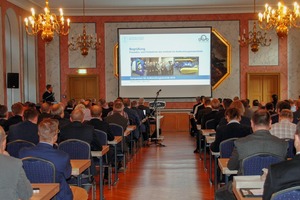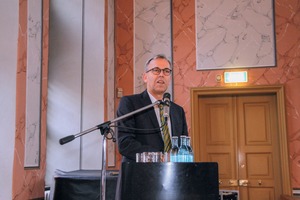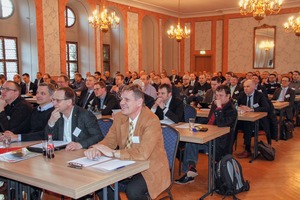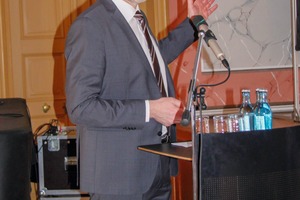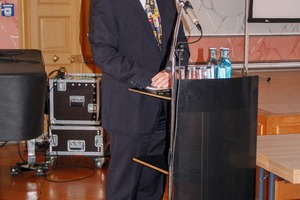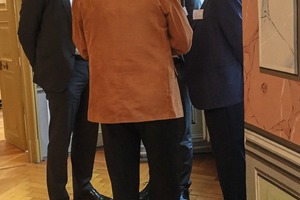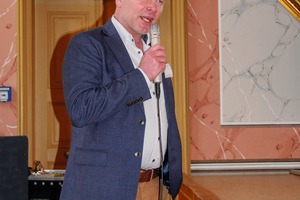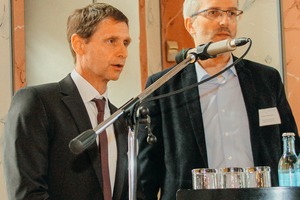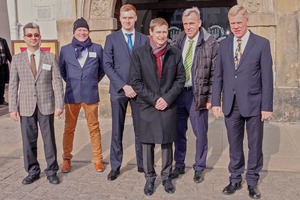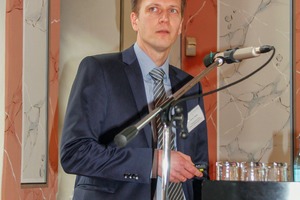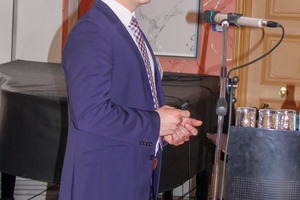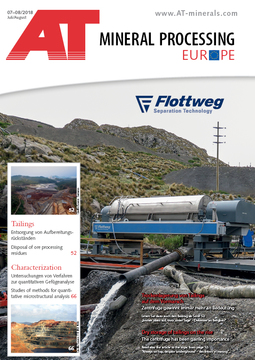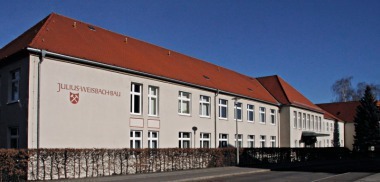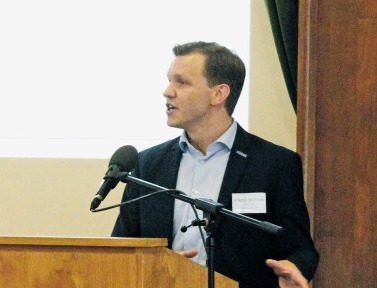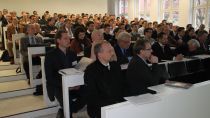Symposium on Mineral Processing 2018
Chairman Florian Festge, Haver & Boecker OHG, kicked off the meeting with a report on the Society of Friends and Supporters of the Institute of Mineral Processing Machines. Besides supporting the Institute in research and development, one focus is making studying at the Institute of Mineral Processing Machines even more attractive – with the goal of increasing the number of new students in Mechanical Engineering in Freiberg to 100 annually by the year 2020. One of the latest measures, he explained, was the redesign of the Institute‘s website to create a more attractive digital platform on which a wide range of advertising campaigns will highlight the fascination of the courses offered and the opportunities that study of mineral processing machines offers for young engineers. For example, on an excursion funded by the Society of Friends and Supporters, ten students were given the opportunity to tour various mines and processing plants in Bulgaria.
In combination with a detailed description of the excursion programme by the Director of the Institute of Mineral Processing Machines, Prof. Dr Holger Lieberwirth, the video then shown gave a lively impression of the excursion. Also provided was a report on the development of the Institute, for example with regard to the number of students compared with other faculties at Freiberg University of Mining and Technology as well as personnel development depending on ongoing research projects. Prof. Lieberwirth reported on completed research projects, for instance with regard to electromobility with a focus on the recyclability of carbon-fibre composites and investment measures for an industrial-scale testing facility at Breitenau Quarry and for the Institute‘s Test Centre.
In the first session of papers, the focus was on mining in Saxony. Prof. Dr Armin Müller, Deutsche Lithium GmbH, Freiberg, reported in his plenary talk on the development and current status of the Zinnwald-Lithium Project undertaken by Deutschen Lithium GmbH. Prof. Müller gave an insight into the different stages of the project; from the already completed exploration campaign, through ore mining and extraction by means of room and pillar technology with planned dry processing and the downstream chemical processes to the finished product. After conclusion of the planning including the licensing procedures as well as conclusion of the financing contracts, the ground-breaking ceremony for the mine ramp is scheduled for July 2019. After the setting up of the site facilities, the first finished product is set to be launched on the market already in July 2021 – only ten years after permission for exploration was granted.
Prof. Dr Georg Unland followed on from his previous year‘s paper with an economic assessment of the financial consequences of mining in Saxony – divided in the paper in three sections on lignite mining, uranium mining and coal, ore mining and abandoned mining. He explained that after the state budget had profited from mining for centuries and had been able to invest in urban development, infrastructure or education, the current situation was characterized by a reversal of affairs: the earlier mining is a burden on the state budget. On account of the consequences of earlier mining, unavoidable remediation and recultivation measures have to be financed – certainly a contentious issue in economic policy with regard to reserves and mining royalties that will probably occupy the state government and tax payers for decades to come.
The innovation potential of proven technologies with reference to the example of crushers was the focus of the following session of papers. Dr Falk Silbermann, thyssenkrupp Industrial Solutions AG, reported on the “Reduction of steel structure vibrations with a new low-vibration jaw crusher”. With the help of an additional balancer shaft, prevailing unbalanced loads could be reduced by 50 % and operational vibrations minimized. The advantages of this innovative patented balancing technology on the basis of the master/slave principle are a low load on the structures surrounding the crusher and a low maintenance requirement with increased cost efficiency as well as more safety in operation. The low-vibration crusher is suitable for use in stationary as well as in mobile and semi-mobile systems.
Hugo van Benthem, Metso Germany GmbH, presented Metso‘s new MX4 gyratory crusher as a milestone, which was launched onto the market in 2017 after a development period of around ten years. The functions of the height-adjustable crusher axle are combined with the rotating upper frame in a single machine. This patented, fully automatic multi-action technology optimizes dynamic crushing gap adjustment and the wear compensation in real time, without manual intervention and interruption of the crushing process. Besides higher availability at lower operating costs and a higher operating and maintenance reliability, van Benthem emphasized first and foremost the optimization of the crushed products on account of the selective production and maximized utilization of the crushing tools up to 70 %.
Dr Rüdiger Heinrich, Haver & Boecker OHG, showed with reference to a fictional aggregate plant the general approach to the “Optimization of processing plants with NIAflow software”. First a model is created in which every machine and the entire material flow in the processing plant are calculated and simulated. Then follows the comparison with real production data obtained with extensive sampling and the verification of the model. This digital twin enables simulation of real operating states to simulate without risk – i.e. without incurring downtime and operating costs – optimization goals with regard to throughput rate, particle shape, material properties such as wear, energy consumption, etc. within defined limits. Besides the increase in efficiency, the program can be used to plan new plants.
The subject of the paper by Jochen Meier, Kleemann GmbH, was how intelligent control systems can be used to meet the requirements of global markets with mobile processing equipment based on the example of material flow regulation and overload systems. The Continuous Feed System (CFS) ensures dynamic control of the material feed based on the material flow by adapting the frequencies of the feeder to the crusher filler level whenever required. Complementing this, for jaw crushers the Load-Reduction System (LRS) is used to avoid short-term and long-term overloading. Flexible adaption of the mobile plants enables optimum utilization and accordingly high productivity – despite a wide range of applications and requirements.
Frank Eichhorn, Max Bögl Stiftung KG, reported on the successful “Realization of a concept for selective comminution in Jurassic limestone”. In the company-owned Wiesenhofen limestone quarry, raw materials are extracted for the production of high-grade concrete and road construction materials. Extensive studies and series of tests with various comminution methods conducted as part of the modernization of the plant‘s extraction and processing operations ensure that the finished products obtained from the limestone at the quarry meet the high quality requirements – with the precondition that, for example, any material content that would damage concrete is removed in a gentle multi-stage processing concept. With the innovative integrated concept, energy consumption has been lowered by 26 % and the part of the deposit that could not be utilized has been reduced by 50 %.
In his paper, Dr Jens Friedrich, TU BAF IAM, presented “Studies on the suitability of selected waste materials in the clay brick and tile industry”, which he had conducted in collaboration with Lisa Kühnel. The studies were part of one of the research projects in the MICROMIN network and concerned the eco-efficient use of microminerals in the production of ceramic building materials. Friedrich outlined the project with the different work contents involved and initial findings. Some of a total of 60 tested waste materials proved promising for the production of high-quality clay bricks and roofing tiles – with the effects of increasing compressive strength, reducing sintering temperature and accordingly lowering energy consumption with simultaneous reduction of fluorine emissions.
The focus of the following paper was medium and fine comminution in the ore industry. Here a technological shift is becoming apparent with conventional, but energy-inefficient tumbling mills being replaced with roller mills – as already successfully realized in the cement industry. Dr Mathis Reichert, Loesche GmbH, reported on “Systematic studies on ore grinding in roller mills” on pilot plant scale, which he conducted in the scope of his dissertation with three different ores at the Loesche GmbH test centre with the LM4.5 pilot-scale roller mill. Here the influence of selected design and operating parameters on target values like product fineness, energy requirement and wear was quantified with the help of regression models to create the basis for optimization of the roller mills for application in the ore industry, too.
The concluding paper “Future-oriented reconfiguration of the measurement systems in a laboratory impact crusher“ by Stephan Lange, TU BAF IAM, addressed the determination of comminution forces in impact crushers, based on the example of the Institute‘s own rotor impact crusher equipped with measurement systems. Besides describing the set-up and operating principle including the advantages of the new measurement solution compared to other measurement methods, Lange reported on new potential applications in fundamental research on selective comminution. The newly configured measurement system enables reliable determination and evaluation of impact events of 30-mm particles at a loading rate up to 60 m/s, which is twice as high as the previous rate.
The breaks during the superbly organized meeting, which on account of renovation work at the Institute was again held in the Civic Hall, and the two evening functions provided an excellent opportunity for exchanging views and ideas as well as for networking. The wide-ranging papers showed impressively how far the need for optimization in every respect is a reliable driver for continuous further development. Accordingly, the next Symposium on Mineral Processing from 7 to 8 March 2019 can be keenly anticipated.
Author/Author:

